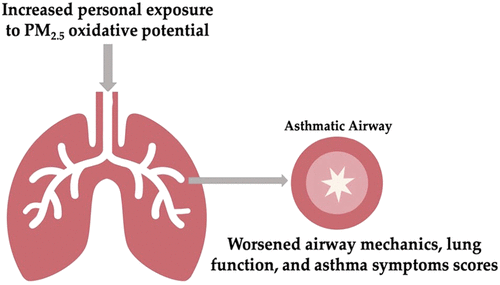当前位置:
X-MOL 学术
›
Environ. Sci. Technol.
›
论文详情
Our official English website, www.x-mol.net, welcomes your feedback! (Note: you will need to create a separate account there.)
Personal Exposure to PM2.5 Oxidative Potential in Association with Pulmonary Pathophysiologic Outcomes in Children with Asthma
Environmental Science & Technology ( IF 11.4 ) Pub Date : 2021-02-08 , DOI: 10.1021/acs.est.0c06114 Linchen He 1, 2 , Christina Norris 3 , Xiaoxing Cui 1 , Zhen Li 4 , Karoline K. Barkjohn 3 , Collin Brehmer 5 , Yanbo Teng 6 , Lin Fang 7, 8 , Lili Lin 4 , Qian Wang 4 , Xiaojian Zhou 4 , Jianguo Hong 4 , Feng Li 9 , Yinping Zhang 7, 8 , James J. Schauer 5 , Marilyn Black 10 , Michael H. Bergin 3 , Junfeng Jim Zhang 1, 2, 6
Environmental Science & Technology ( IF 11.4 ) Pub Date : 2021-02-08 , DOI: 10.1021/acs.est.0c06114 Linchen He 1, 2 , Christina Norris 3 , Xiaoxing Cui 1 , Zhen Li 4 , Karoline K. Barkjohn 3 , Collin Brehmer 5 , Yanbo Teng 6 , Lin Fang 7, 8 , Lili Lin 4 , Qian Wang 4 , Xiaojian Zhou 4 , Jianguo Hong 4 , Feng Li 9 , Yinping Zhang 7, 8 , James J. Schauer 5 , Marilyn Black 10 , Michael H. Bergin 3 , Junfeng Jim Zhang 1, 2, 6
Affiliation

|
Fine particulate matter (PM2.5) with a higher oxidative potential has been thought to be more detrimental to pulmonary health. We aim to investigate the associations between personal exposure to PM2.5 oxidative potential and pulmonary outcomes in asthmatic children. We measured each of the 43 asthmatic children 4 times for airway mechanics, lung function, airway inflammation, and asthma symptom scores. Coupling measured indoor and outdoor concentrations of PM2.5 mass, constituents, and oxidative potential with individual time–activity data, we calculated 24 h average personal exposures 0–3 days prior to a health outcome measurement. We found that increases in daily personal exposure to PM2.5 oxidative potential were significantly associated with increased small, large, and total airway resistance, increased airway impedance, decreased lung function, and worsened scores of individual asthma symptoms and the total symptom score. Among the PM2.5 constituents, organic matters largely of indoor origin contributed the greatest to PM2.5 oxidative potential. Given that the variability in PM2.5 oxidative potential was a stronger driver than PM2.5 mass for the variability in the respiratory health outcomes, it is suggested to reduce PM2.5 oxidative potential, particularly by reducing the organic matter constituent of indoor PM2.5, as a targeted source control strategy in asthma management.
中文翻译:

哮喘儿童个人暴露于PM 2.5氧化潜能与肺部病理生理结果的关系
具有较高氧化潜力的细颗粒物(PM 2.5)被认为对肺部健康有害。我们的目的是调查哮喘儿童的个人暴露于PM 2.5氧化潜能与肺结局之间的关系。我们对这43名哮喘儿童中的每一个进行了4次测量,以评估其气道力学,肺功能,气道炎症和哮喘症状评分。结合室内和室外的PM 2.5质量浓度,成分和氧化电位与个人时间活动数据的耦合,我们在健康结果测量之前的0至3天计算了24小时的平均个人暴露量。我们发现,个人每日暴露于PM 2.5的情况有所增加氧化电位与小,大和总气道阻力增加,气道阻抗增加,肺功能下降以及个体哮喘症状评分和总症状评分恶化显着相关。在PM 2.5的成分中,主要来自室内的有机物对PM 2.5氧化电位的贡献最大。鉴于PM 2.5氧化电位的变化对呼吸健康结果的变化具有比PM 2.5质量更强的驱动力,建议降低PM 2.5的氧化电位,特别是通过减少室内PM 2.5的有机物成分,作为哮喘管理中的有针对性源控制策略。
更新日期:2021-03-02
中文翻译:

哮喘儿童个人暴露于PM 2.5氧化潜能与肺部病理生理结果的关系
具有较高氧化潜力的细颗粒物(PM 2.5)被认为对肺部健康有害。我们的目的是调查哮喘儿童的个人暴露于PM 2.5氧化潜能与肺结局之间的关系。我们对这43名哮喘儿童中的每一个进行了4次测量,以评估其气道力学,肺功能,气道炎症和哮喘症状评分。结合室内和室外的PM 2.5质量浓度,成分和氧化电位与个人时间活动数据的耦合,我们在健康结果测量之前的0至3天计算了24小时的平均个人暴露量。我们发现,个人每日暴露于PM 2.5的情况有所增加氧化电位与小,大和总气道阻力增加,气道阻抗增加,肺功能下降以及个体哮喘症状评分和总症状评分恶化显着相关。在PM 2.5的成分中,主要来自室内的有机物对PM 2.5氧化电位的贡献最大。鉴于PM 2.5氧化电位的变化对呼吸健康结果的变化具有比PM 2.5质量更强的驱动力,建议降低PM 2.5的氧化电位,特别是通过减少室内PM 2.5的有机物成分,作为哮喘管理中的有针对性源控制策略。



























 京公网安备 11010802027423号
京公网安备 11010802027423号